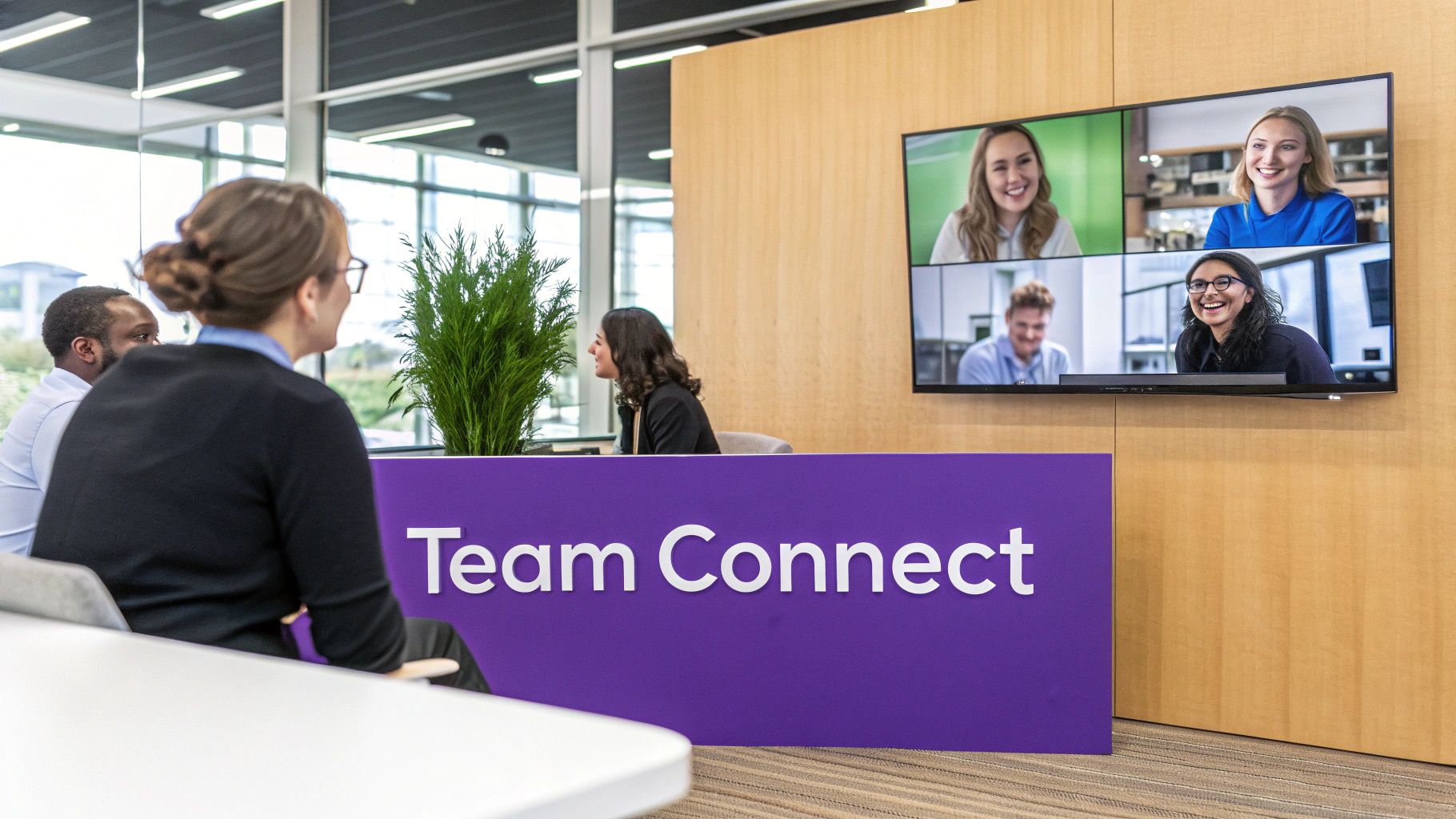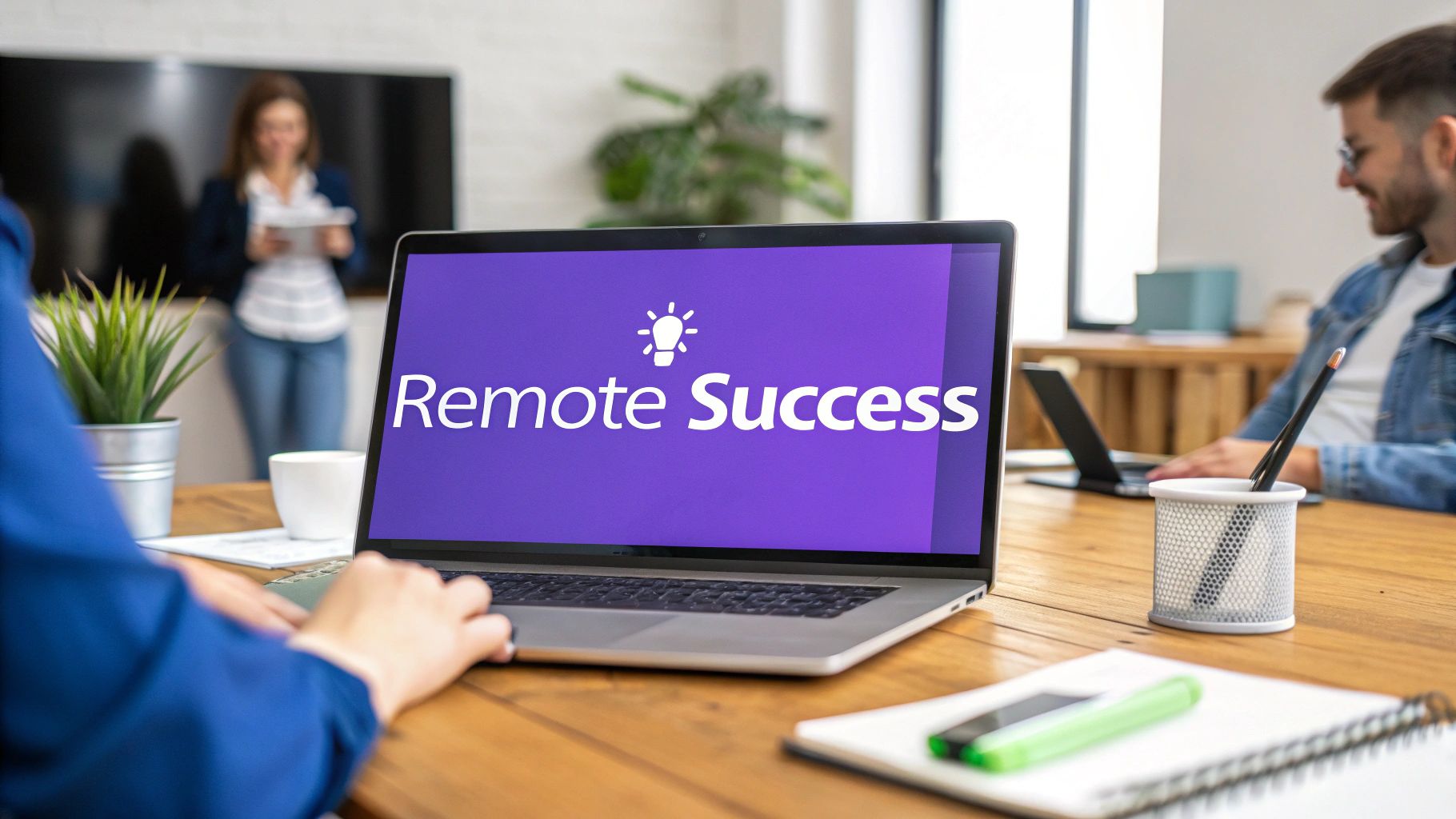The Remote Onboarding Revolution: Challenges Worth Solving

Successfully onboarding new hires remotely presents a unique set of challenges. Unlike traditional in-person onboarding, building connections, transferring knowledge, and fostering a sense of belonging requires a different approach. This means understanding the core challenges and developing strategies for a positive remote employee experience.
One of the biggest difficulties is recreating the informal interactions and spontaneous learning that happen naturally in an office. For example, new remote employees miss out on quick questions to colleagues, overhearing project conversations, and observing company culture firsthand. Organizations must be more intentional about creating opportunities for virtual connection and knowledge sharing.
Additionally, remote onboarding introduces technical and logistical complexities. Ensuring new hires have the necessary equipment, software, and access can be challenging. Providing clear instructions and support for navigating digital platforms like Slack is crucial for a smooth onboarding experience. These logistical roadblocks can cause frustration and hinder productivity.
These challenges have real consequences. Recent studies paint a concerning picture. 63% of remote employees report inadequate training during onboarding, and 60% feel disoriented afterward. 36% of remote workers found their onboarding confusing. Find more detailed statistics here. This highlights the need for improved processes.
The Psychological Impact of Poor Remote Onboarding
Poor remote onboarding can significantly impact new hires psychologically. Feeling isolated, confused, and unsupported can decrease motivation and engagement, ultimately leading to higher turnover. This negatively affects both the individual and the organization.
Disoriented employees struggle to contribute effectively, impacting team performance and project timelines. They may hesitate to ask questions, fearing they'll appear incompetent. This creates a cycle where a lack of clarity decreases confidence and hinders team integration.
Turning Challenges Into Opportunities
These challenges also present opportunities. By addressing the unique needs of remote employees, organizations can create a competitive advantage. Effective remote onboarding can increase employee engagement, speed up time to productivity, and improve retention.
This means investing in the right tools, processes, and training to support remote employees. It also means fostering open communication and feedback, ensuring new hires feel comfortable asking questions and seeking support.
Let's look at a comparison of remote and in-person onboarding experiences. The following table highlights key differences based on recent research data:
Remote vs. In-Person Onboarding Experience Comparison
This table will compare key experience metrics between remote and in-person onboarding processes based on recent research data.
| Experience Metric | Remote Onboarding | In-Person Onboarding | Gap |
|---|---|---|---|
| Feeling of Connection | Often lower due to lack of informal interaction | Generally higher due to face-to-face interactions | Significant |
| Access to Information | Can be challenging due to reliance on digital platforms | Easier access through direct communication | Moderate |
| Clarity of Expectations | Can be ambiguous without clear communication channels | Usually clearer due to direct observation and feedback | Moderate |
| Sense of Belonging | Can be difficult to foster remotely | Develops more naturally in a shared physical space | Significant |
| Technical Issues | More frequent due to varied setups and remote troubleshooting | Less frequent with on-site IT support | Significant |
This table shows key differences in the onboarding experience, emphasizing the need for focused efforts to bridge the gap in remote settings. By focusing on connection, clear communication, and robust technical support, organizations can create a more positive and productive remote onboarding experience. By embracing these challenges, organizations can build stronger, more connected remote teams.
Crafting Your Remote Onboarding Blueprint

Successfully onboarding remote employees requires a detailed plan. Simply transferring in-person processes to a virtual setting isn't enough. You need to address the specific needs and challenges remote employees face. This means structuring the entire onboarding experience, from pre-boarding to full team integration.
One crucial first step is establishing a clear timeline for the first 90 days. This timeline should outline important milestones, deliverables, and regular check-ins.
For example, the first week might prioritize setting up equipment, accessing company systems, and introductions to the immediate team. The first month could then focus on project onboarding, initial training, and introductions to the wider team. The 90-day mark should ideally see the new hire fully integrated into the team and actively contributing to projects. This structured approach provides a clear roadmap for both the new employee and their manager.
Structuring the First 90 Days
A well-defined 90-day structure is vital for remote onboarding success. It should incorporate a balance of synchronous and asynchronous activities. Synchronous activities, such as live video meetings, enable real-time interaction and build relationships. Asynchronous activities, such as pre-recorded training videos or online documentation, offer flexibility and allow new hires to learn at their own speed.
Think of the onboarding journey as a series of interconnected stages. Pre-boarding, the time before the employee's official start date, sets the stage. This is the perfect opportunity to send welcome materials, ensure the employee has the necessary equipment, and grant access to key systems. Initial onboarding then concentrates on fundamental knowledge and team introductions. Finally, the integration phase aims to fully embed the new hire into the team and company culture.
To help visualize the essential components, let's look at the following table:
Essential Components of Remote Onboarding Framework
| Timeline | Key Components | Tools/Resources Needed | Success Metrics |
|---|---|---|---|
| Pre-Boarding | Welcome package, IT setup, Access to systems | BambooHR | Completion of pre-boarding tasks, System access confirmed |
| Week 1 | Team introductions, Goal setting, Initial project assignments | Video conferencing software, Project management tools | Introduction to team members, Clear goals established |
| Month 1 | Foundational training, Department introductions, Performance check-in | Learning Management System (LMS), Performance management software | Completion of training modules, Feedback received |
| 90 Days | Project contributions, Team integration, Performance review | Project management tools, Communication platforms | Active project involvement, Positive feedback from team members |
This table provides a framework for building a successful remote onboarding program. Remember to tailor these components to your specific company needs.
Establishing Psychological Safety From Day One
Creating a sense of psychological safety is crucial in remote settings, where new hires can feel isolated. This means fostering a culture where employees feel comfortable asking questions, voicing concerns, and taking risks without fear of judgment. This starts with open communication from leaders and managers, who should actively solicit feedback and demonstrate their own vulnerability.
For instance, managers can share their own experiences of adapting to remote work or acknowledge the challenges of virtual onboarding. This fosters a sense of shared experience and encourages open dialogue. Regular check-ins and multiple communication channels – such as instant messaging, video calls, and email – also support a positive and inclusive environment.
The global onboarding software market is expected to reach $1.7 billion by 2026, growing at a 2.5% CAGR. This growth highlights the increasing importance companies place on streamlining onboarding, especially for remote hires. Effective onboarding tools are essential for addressing inefficiencies, given that only 12% of U.S. employees view their company's onboarding favorably. However, effective onboarding increases employee retention by 82%. More detailed statistics can be found here: https://www.strongdm.com/blog/employee-onboarding-statistics. Investing in technology reflects the growing demand for structured and supportive remote onboarding experiences.
Building Digital Pathways
Creating clear digital pathways is key for remote employees navigating a new work environment. This means providing user-friendly resources, clear documentation, and easy access to crucial systems. It also involves using technology effectively. A centralized onboarding portal, for example, can house all onboarding materials, training resources, and company information. For additional tips on remote team building, see: How to master remote team building.
The Technology Stack That Powers Remote Connection

Effective remote onboarding goes beyond simple video calls. It needs a well-chosen group of technologies that strengthen connections, simplify processes, and help new hires feel like they belong. This section explores the tools and platforms that truly deliver a return on investment while avoiding unnecessary complexity.
Essential Tools for Seamless Remote Onboarding
A strong remote onboarding tech stack should cover several key areas. First, communication and collaboration platforms are vital. These tools, such as Slack or Microsoft Teams, enable real-time interaction, letting new hires connect with their team and ask questions quickly.
Secondly, a learning management system (LMS) is crucial. An LMS delivers training materials, tracks progress, and assesses knowledge. This centralizes resources and creates a structured training approach, allowing new hires to learn at their own pace and review content as needed.
Thirdly, project management tools are key. These tools help assign tasks, track progress, and encourage collaboration, giving new hires visibility and accountability, so they can quickly contribute to team goals.
Finally, consider tools made for remote team building and engagement. These tools help create a more personal and connected experience, fostering a sense of community among remote employees.
For example, a platform like Bulby encourages brainstorming and creative collaboration from the start. Its structured exercises ensure new hires feel included and empowered to share ideas, despite being remote. This can significantly impact how well they integrate with the team.
Integrating Your Tech Stack for a Cohesive Experience
Just having these tools isn't enough; they must work together smoothly. Separate systems create friction and confusion for new hires. The ideal setup allows information and activities to flow easily between platforms.
This might involve integrating your LMS with your communication platform, so new hires get training assignment notifications directly in their team chat. Or, you could connect your project management tool with your performance management system to track progress toward goals.
Avoiding Tech Overload and Maximizing ROI
While technology is vital, too many tools can overwhelm new hires. Organizations should carefully evaluate which platforms are truly necessary and avoid adding unnecessary complexity. Each tool should have a clear purpose and demonstrable value.
For instance, using multiple communication platforms for different purposes can be counterproductive. Consolidating communication into one platform simplifies things for everyone.
Likewise, investing in overly complex LMS platforms with unused features can be a waste. A simpler, more intuitive system might be better. Learn more in our article about Collaboration Tools for Remote Teams. Careful evaluation maximizes your technology ROI and creates a better onboarding experience.
Prioritizing Accessibility and Security
When choosing your remote onboarding tech stack, prioritize accessibility and security. Ensure all platforms meet accessibility standards, accommodating employees with diverse needs. This includes considerations for screen readers, keyboard navigation, and closed captioning.
Security is critical, especially when handling sensitive employee data. Select platforms with strong security features, like two-factor authentication and data encryption. This protects your organization and builds trust with new hires.
By focusing on a cohesive, accessible, and secure technology approach, organizations can create a smooth, efficient, and positive remote onboarding experience for everyone. This sets the stage for long-term success and a thriving remote workforce.
Building Authentic Connections Across Digital Divides

Genuine human connection is the bedrock of any successful team, and remote teams are no exception. Fostering this connection in a virtual environment, however, presents unique challenges. This section explores proven methods for creating a sense of belonging and camaraderie among remote employees, even when separated by distance. It means going beyond basic online interactions and intentionally designing virtual experiences that encourage authentic relationships.
Structuring Meaningful Virtual Interactions
Remote onboarding shouldn't just replicate in-person processes online. It needs to be reimagined for the digital space. This involves structuring virtual interactions in a way that fosters connection.
For example, instead of relying solely on large, impersonal video conferences, consider smaller, more focused group discussions. This allows for more personalized interactions. It also gives new hires a chance to connect with their team members on a more individual level.
Additionally, incorporating interactive elements into virtual meetings can greatly enhance engagement. It creates a more dynamic experience. Think about using online whiteboards like Miro for collaborative brainstorming. You could also incorporate online polls and quizzes to keep participants actively involved. These activities not only facilitate learning but also create opportunities for informal interaction and team building.
This intentional design is crucial for combating the isolation that remote employees can sometimes feel. It means incorporating opportunities for social interaction alongside work-related tasks.
Designing Effective Team-Building Activities
Team-building activities are essential for building rapport and fostering a sense of community among remote team members. However, it's critical that these activities don't feel forced or artificial. Instead, they should be engaging, relevant, and aligned with the team's overall goals.
One highly effective approach is to implement thoughtfully designed buddy programs. These programs pair new hires with existing employees who can offer support, guidance, and a friendly face during the onboarding process. Unlike traditional mentorships, which focus primarily on professional development, buddy programs prioritize social connection and integration into the team culture.
These personalized interactions create a sense of belonging from day one. You might be interested in: How to master remote team building.
Building Trust Through Micro-Interactions
While formal team-building activities are important, micro-interactions play a crucial role in building trust and rapport over time. These small, everyday interactions create a sense of connection and shared experience. Examples include a quick hello in the team chat, a supportive comment on a project update, or a virtual coffee break with a colleague.
Think of these interactions as the digital equivalent of water cooler conversations or casual hallway chats. They may seem insignificant on their own, but they cumulatively contribute to a strong team culture.
Communication Practices for Building Authentic Relationships
Effective communication is the lifeblood of successful remote teams. This involves establishing clear communication channels and protocols from the outset. For example, designating specific channels for different project updates, team announcements, or social conversations can help streamline communication and prevent information overload.
Additionally, encouraging the use of video conferencing tools like Zoom for team meetings and one-on-one check-ins can help personalize interactions and build rapport. Seeing each other's faces and body language adds a layer of richness to communication that is often missing in text-based exchanges.
This helps build stronger, more authentic relationships despite the lack of physical proximity. Encouraging remote employees to share aspects of their lives outside of work can also create a stronger sense of connection and shared experience.
Measuring What Matters: Remote Onboarding Success Metrics
How can you gauge the effectiveness of your remote onboarding program? While subjective feedback is helpful, a solid measurement framework is crucial. This means tracking key metrics that show the real impact of your onboarding process. By analyzing both leading indicators (predictive measures) and lagging indicators (outcome measures), you'll get a complete understanding of your program's success.
Leading Indicators: Early Signs of Success
Leading indicators offer early glimpses into how well your remote onboarding is working. These metrics help you spot potential problems early on, allowing you to make adjustments quickly. One important leading indicator is early engagement. Are new hires actively participating in team meetings, online discussions, and training? High engagement often means a smoother transition and better integration.
Another key metric is time to first contribution. How long does it take for new hires to start contributing to projects or tasks? This shows how quickly they become productive team members. Tools like Asana or Monday.com can help track task completion and project involvement. These early signs of engagement and contribution are good predictors of long-term success.
Lagging Indicators: Long-Term Impact
Leading indicators give you early insights, but lagging indicators show the long-term effects of your remote onboarding program. Retention rates for new hires are a critical lagging indicator. High retention usually means a positive onboarding experience and a good fit with the company culture. This data reveals how well your onboarding integrates new hires into the team.
Regular performance reviews also give valuable feedback on how well new hires have adapted to their roles and the remote work environment. Consistently positive performance reviews suggest effective onboarding and strong team integration. Combine performance data with feedback from team leaders and peers to get a well-rounded perspective.
Building a Data-Driven Approach
To effectively measure your remote onboarding success, build a dashboard that tracks both leading and lagging indicators. This dashboard gives you a centralized view of your program's performance. You can then pinpoint areas for improvement and monitor progress. For example, if early engagement is low, you could add more interactive elements to your onboarding.
Implementing continuous feedback loops is essential. Regularly checking in with new hires offers valuable insights into their experiences and helps identify any challenges they’re facing. Using platforms like Bulby can improve brainstorming and project collaboration from day one. This proactive approach helps address problems before they become major issues, enabling data-driven improvements to your remote onboarding process. By consistently analyzing data and gathering feedback, you can refine your approach and create a truly successful onboarding experience for your new remote hires.
Personalizing Remote Onboarding Across Roles and Levels
A one-size-fits-all approach to remote onboarding just won't cut it. Different roles and levels within an organization have unique needs and require tailored onboarding experiences. This section explores how to personalize onboarding while maintaining scalability.
Tailoring Onboarding for Different Roles
Think about the different needs of each role. A remote executive needs a high-level understanding of the organization’s strategy, goals, and their contribution to overall success. Their onboarding should prioritize introductions to key leadership, a grasp of the company vision, and relationship building with other executives.
Remote managers, however, need training on leading virtual teams, building trust remotely, and navigating communication challenges. They require resources and support to foster a positive and productive remote work environment. This might include training on conflict resolution, performance management, and virtual team-building activities.
Individual contributors often require more role-specific technical training and resources. For example, a software developer might need access to GitHub repositories and training on specific programming languages, while a marketing specialist might need access to HubSpot and training on content strategy. Their onboarding should equip them with the tools and knowledge to excel in their individual roles.
Finally, client-facing roles need training on representing the company culture and building client rapport remotely. They need resources on virtual communication best practices, cultural sensitivity, and building strong client relationships through digital channels. This might involve role-playing, client communication templates, and training on using Zoom effectively.
Balancing Standardization and Personalization
While personalization is key, standardization is essential for efficiency. A core onboarding program covering company-wide policies, values, and essential tools provides a foundation for all new hires. This can be supplemented with role-specific modules and resources. This balanced approach allows for both scalability and personalized support.
For instance, a core program might cover IT setup, company benefits, and compliance training. Role-specific modules, like leadership training for managers or sales training for client-facing roles, would then be added.
Adapting Content for Diverse Learning Styles
Everyone learns differently. A truly personalized onboarding experience offers a variety of learning formats. Some employees prefer self-paced online modules, while others thrive in live virtual training sessions or interactive group discussions.
Using tools like Bulby can be incredibly helpful for remote teams onboarding new members. Its structured exercises ensure that even new hires feel comfortable contributing and sharing ideas.
Accommodating Cultural Variations
For global organizations, cultural sensitivity is crucial. Onboarding materials and communication should be inclusive, considering different communication styles, holidays, and work norms. This might involve translating materials or adjusting training schedules to accommodate time zones.
Implementing a Multi-Tiered Onboarding System
A multi-tiered approach facilitates both standardization and personalization. The first tier offers foundational information for all employees. Subsequent tiers offer tailored content based on roles, departments, or locations. This structure scales remote onboarding while providing a relevant and personalized experience.
By incorporating role-specific checklists, modification guidelines, and implementation roadmaps, organizations can efficiently address the diverse needs of a remote workforce. This ensures every new hire, regardless of role or location, feels supported and prepared from day one.
The Future of Remote Onboarding: Trends Worth Watching
The world of remote work is constantly changing, and onboarding practices need to adapt. Looking ahead, several trends are set to reshape how we integrate new remote employees, making the process more engaging, personalized, and ultimately, more effective.
Immersive Learning Environments: Beyond the Webinar
Immersive learning environments are pushing beyond the limitations of traditional webinars and online courses. These interactive experiences replicate real-world scenarios, offering a practical approach to learning. Imagine new hires participating in simulated project meetings, navigating a virtual office, or even taking part in role-playing exercises within a digital twin of their workspace. This hands-on approach allows new hires to apply their knowledge, hone their skills, and build confidence in a safe and supportive setting. It's like a flight simulator, preparing them for the day-to-day realities of their new roles.
This style of learning is particularly beneficial for remote employees, who often miss out on the informal, in-person learning opportunities that arise in a traditional office environment.
AI-Powered Personalization: The Right Content at the Right Time
AI-powered personalization is becoming increasingly important in remote onboarding. AI algorithms analyze employee data, including job role, skill level, and learning preferences, to create a tailored onboarding experience. This ensures that each new hire receives the most relevant content at the optimal time, maximizing learning and engagement. AI can also recommend additional training resources or connect new hires with mentors and colleagues who share similar interests and skill sets. This level of personalization creates a more efficient and impactful onboarding journey.
Virtual Reality Team Experiences: Building Connection in the Metaverse
Virtual Reality (VR) team experiences, though still an emerging technology, hold immense potential for transforming how remote teams connect and collaborate. Imagine new hires attending team meetings in a shared virtual space, participating in team-building activities within a virtual world, or even exploring a virtual replica of the company's office. VR can bridge the physical distance between remote and in-person interactions, creating a stronger sense of connection and belonging. This technology allows new hires to experience company culture firsthand and build relationships with colleagues in a more engaging and immersive way.
Preparing for the Future of Remote Onboarding
These emerging trends offer an exciting preview of what the future of remote onboarding holds. While some of these technologies are still developing, organizations can start preparing today. Staying informed about the latest advancements, experimenting with new tools and platforms like Bulby, and fostering a culture of innovation within HR teams are crucial steps. By embracing these forward-thinking strategies, organizations can craft remote onboarding experiences that are not just effective, but also engaging and enjoyable for new hires.
Start building a more connected and innovative remote team today with Bulby, the brainstorming platform designed for the future of work. Learn more about how Bulby can transform your team's collaboration.

